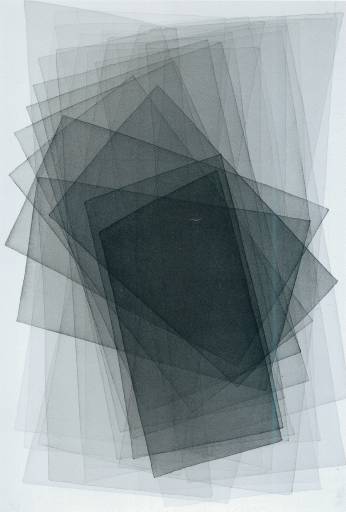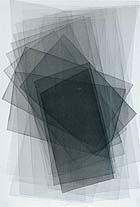
translated and summarized by: Liz Wollner-Grandville,
English summary April 21 - 27
artmark Galerie Wien: Joachim Bandau
Paint to meditate
The first impression one gets when entering the exhibition rooms is that of absolute quiet and concentration. Only after a detailed examination can one recognize the pale grey shaded aquarelles as such. The edges of these pale-grey rectangles are so exact that they appear like lithographies or laser prints.
The formal clarity of Joachim Bandau’s abstract compositions is convincing. His “black aquarelles” convey calmness and simplicity. However, the application of just one colour (black) and one form (rectangle), enables these works to transmit more complexity and intricacy than many others.
The long and meditative process behind the creation of these paintings is evident. These clear and precise pieces of art require a long and dedicated manual procedure. The artist can only add one layer (rectangle) at a time, which is then pressed and dried for weeks before the next layer can be applied. This also explains why you will not find one single carelessly applied brushstroke – it would ruin months of hard work.
The form Bandau uses in his oeuvre does not stay an end in itself – he succeeds in mediating an idea as well as a meaning with his art.
artmark Galerie Wien
1010 Vienna, Singerstrasse 17, until 03.05.08
www.artmark.at
Galerie Hohenlohe: Dominik Steiger – Kosmöschen (Diminutive cosmos) Steiger
Klee from underneath
Dominik Steiger is a master of the small format. This is where he takes after Paul Klee. Both work in a monomaniac manner, but with a lot of humour and scurrility. Steiger is meticulous about his work and one can sense how closely he bent over his paintings and collages and pedantically worked on every little detail.
The Gallery Hohenlohe is showing Steiger's complete oeuvre, which he has created over the last 35 years. Among them his early works “Knöchelchen”, photographs, books, and Kulturcollages. Steiger disseminates messages; whatever comes across this artist’s childlike fantasy that could be utilized as a media for his messages, is eagerly implemented.
Galerie Hohenlohe
1010 Vienna, Bäckerstrasse 3, until 10.05.08
www.galeriehohenlohe.at
Museum Gunzenhauser – Art Collections Chemnitz
Many cities competed for Dr. Alfred Gunzenhauser’s collection of 20th century German art with its main emphasis on German Expressionism and New Objectivity (Neue Sachlichkeit) as well as some positions of the post-war period. Now it has found a home in the recently opened Museum Gunzenhauser in Chemnitz. Gunzenhauser, the Munich-based gallery owner, presented Chemnitz with 500 paintings and 2000 graphic works in the form of a foundation.
The Foundation Gunzenhauser is contractually tied to Chemnitz for 150 years, giving the city the comfortable feeling that the collection will not be pulled out too soon. However, it does remain questionable if a private collection should be funded with public money and thereby become a kind of eternal memorial. Even if two thirds of the reconstruction of the historic bank building were funded privately, public money will be used for the maintenance and the financing of the exhibits.
On the other hand this is the only way in which the public has access to Gunzenhauser's collection – and it includes some magnificent pieces. Among them are a self-portrait of Otto Dix and his lithography “Leonie”, as well as a series of works by Alexej von Jawlensky.
All in all the collection is very heterogeneous and it considers itself to be the “world’s largest museum collection of works by Otto Dix”. But you won’t find many paintings of the New Objectivity among the 290 displayed pieces. Dix’s old masterly landscapes are only a exiguous consolation – they are more of an oddity than an artistic treat.
Even if the Museum Gunzenhauser enhances Chemnitz, it remains extremely doubtful if it can boost the city the city to attain the rank of an art metropolis.
www.kunstsammlungen-chemnitz.de
National Portrait Gallery: Vanity Fair Portraits: Photographs 1913 – 2008
Those were the days
Vanity Fair has attainted the status of a cultural catalyst – be it regarding socio-cultural aspects, fashion, or portrait photography. The US publisher Condè Nast purchased the British weekly magazine in 1914 and after a slow start, he employed Frank Crowninshield, who created a fabulous platform for contemporary literature. This is where Dorothy Parker published her first poem and F. Scott Fitzgerald’s placed his early works. In 1923 Crowninshield managed to publish texts by Djuna Barnes, T.S. Eliot, Aldous Huxley and Gertude Stein in just one edition. Among Vanity Fair’s photographers you will find celebrities such as Cecil Beaton, George Hoyningen-Huene, Martin Munkácsi or Man Ray. The magazine suspended publication in 1936 and was relaunched in 1983.
The exhibit at the National Portrait Gallery shows photographs dating from the eras: 1914 to 1936 and 1983 to 2008 – however, it fails to inform on many important aspects. There is not enough information about the history of the magazine nor is its history set in a broader context. It is rather insufficient to solely concentrate on displaying photographs, and thereby not enabling much of a dialogue - even if original editions of the magazine complement some of the exhibited works. But the show also offers some photographic highlights: among them the photo of the silent movie star Gloria Swanson by Edward Steichen, one of the magazine’s head photographers or the photo of Robert Mitchum, standing at a pier in a soaked trench coat, taken by Annie Leibovitz.
On the one hand photography and its significance has transformed immensely in the two eras represented at this exhibit; on the other hand the choice of the works displayed clearly reflect the magazine’s stance: photos of Einstein, Joyce or the Sitwells meet with those of Demi Moore, Jennifer Lopez or the incredible family photo of Tom Cruise with wife and child (revealingly an explanatory note was missing). In any case, it is hard to develop enthusiasm at this exhibit, not even if you leave your Kulturpessimismus aside for just a few moments.
National Portrait Gallery
WC2H 0HE London, St. Martin’s Place, until 26. 05. 2008
www.npg.org.uk
Mehr Texte von translated and summarized by: Liz Wollner-Grandville


 Teilen
Teilen





